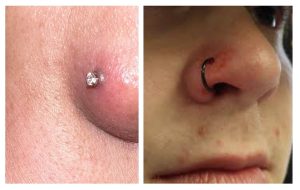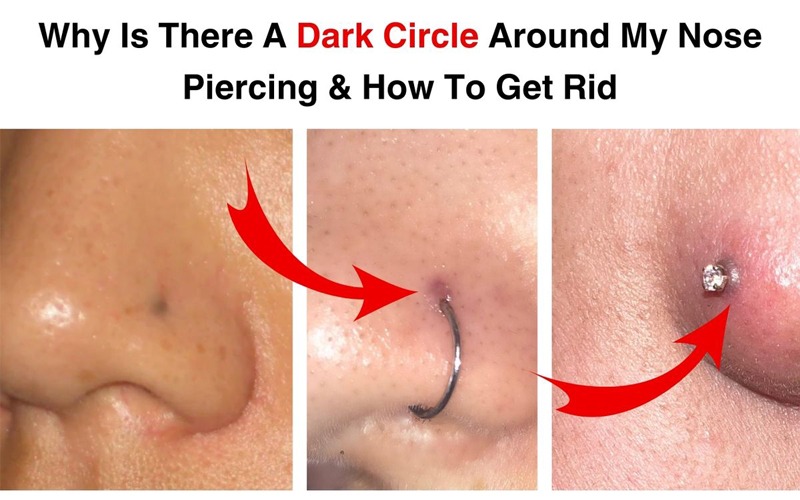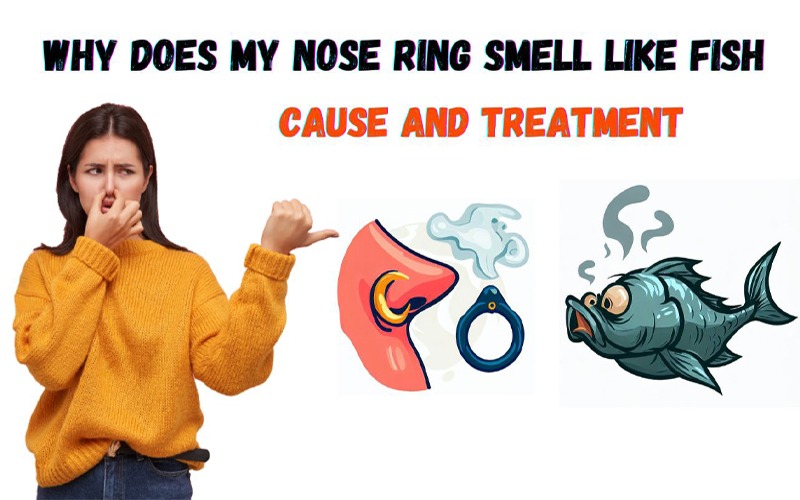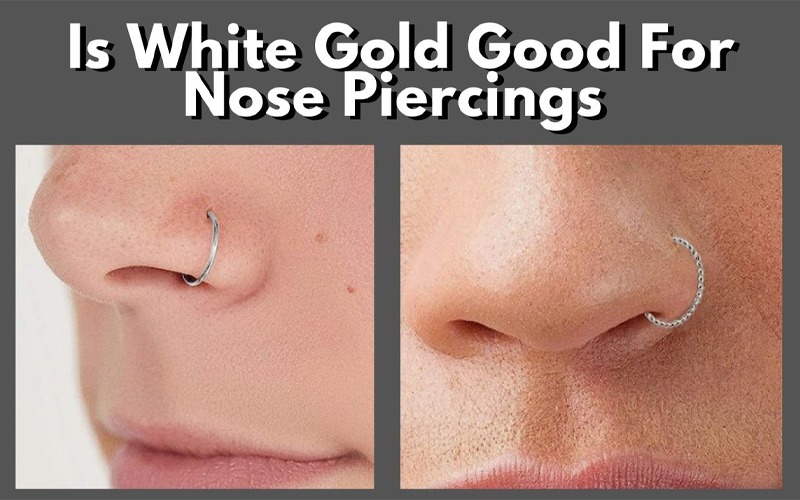After piercing, many of us may notice a dark circle or black ring around our nose piercing. But why is there a dark circle around my nose piercing?
There are several reasons why we can have dark circles around nose piercings. The main reason for a dark circle around the nose piercing is localized bruising, which can occur during the piercing process when small blood vessels break.
Also, irritation from jewelry movement, clothing, or touching the piercing site can cause discoloration or dark circles. Proper aftercare, using hypoallergenic jewelry, and avoiding excessive manipulation can help prevent dark circles around nose rings.
Today, in this article we will tell you why is there a black ring around my nose piercing and what to do to get rid of black or dark rings around nose rings.
Ingredients to remove dark spots around nose piercing
Aloe Vera Gel | Tea Tree Oil | Vitamin E Oil |
[amazon fields="B09JGSRPZ5" value="thumb"] | ||
Why Is There A Black Ring Around My Nose Piercing

Dark circles around a nose piercing can be attributed to various factors, often related to the healing process and how your body reacts to the piercing. Here’s a more detailed description of why this dark circle might occur:
Bruising and Trauma:
When you get a nose piercing, it involves puncturing the skin and underlying tissue. This can cause minor trauma and damage to the blood vessels in the area, leading to bruising.
Bruised skin often appears darker in color, creating a temporary dark circle around the piercing. This is a common occurrence, especially shortly after getting the piercing or if the piercing has been accidentally bumped or disturbed.
Inflammation And Irritation:
The body’s natural response to injury or foreign objects is inflammation. Inflammation can cause redness and swelling, which may contribute to the appearance of a dark circle around the piercing.
Not just dark circles, you may notice white or red circles also because of irritation. Yes, sometimes you may notice a red ring around your nose piercing, but why? Because of irritation, this can result from various factors, including jewelry materials that your skin may be sensitive to or improper aftercare practices.
Allergic Reactions:
Some individuals are allergic to certain metals commonly used in jewelry, such as nickel. If your body reacts to the jewelry with an allergic response, it can lead to localized skin irritation, redness, and darkening of the skin around the piercing.
Infection:
Infections in and around a nose piercing can cause the skin to become inflamed and discolored. This might manifest as a dark circle, along with symptoms like pain, discharge, and increased redness. Infections require prompt attention and treatment by a healthcare professional.
Hyperpigmentation:
Hyperpigmentation occurs when the body produces excess melanin in response to trauma or inflammation. This can lead to the skin becoming darker in color around the piercing site. Hyperpigmentation can persist even after the piercing has fully healed.
Scar Tissue:
Formation of scar tissue, such as keloids or hypertrophic scars, can lead to localized skin darkening. Scar tissue development is more likely in individuals prone to keloids or when a piercing experiences trauma or irritation during the healing process.
So these are the main factors why is there a dark circle around my nose piercing. Some of these factors can contribute white circle during your healing period. If you notice a white circle also and don’t know why there is a white circle around the nose piercing, then you can follow our previous article.
How To Get Rid Of Dark Spot Around Nose Piercing
Getting rid of a dark spot around a nose piercing involves several approaches, depending on the cause of the discoloration. Here are some steps to get rid of dark spots around nose piercing:
Step 1: Proper Aftercare
If your piercing is still healing, continue to follow proper aftercare procedures. Clean the area daily with a saline solution or a saline-based piercing solution, and avoid touching or twisting the jewelry unnecessarily.
Step 2: Hypoallergenic Nose Ring
Ensure that you are wearing nose rings which are made from hypoallergenic materials that your skin does not react to. Avoid jewelry containing nickel, as it can cause allergic reactions and skin discoloration.
Step 3: Avoid Unnecessary Irritation
Be gentle with your piercing. Avoid activities that could irritate the area, such as excessive movement of the jewelry or exposure to harsh chemicals or cosmetics.
Step 4: Consult A Dermatologist
If the dark spot is due to hyperpigmentation or scar tissue, consider consulting a dermatologist. They can provide treatment options such as topical creams or laser therapy to reduce discoloration.
Step 5: Sun Protection
If hyperpigmentation is the cause, protect the area from sun exposure. Use sunscreen or cover the area with clothing to prevent further darkening.
Step 6: Scar Management
If the dark spot is caused by scar tissue, a dermatologist can recommend treatments to help reduce its appearance, such as silicone gel sheets or corticosteroid creams.
Step 7: Avoid Home Remedies
Avoid using home remedies that are not recommended by a professional, as they can sometimes worsen the situation or cause further irritation.
Is It Normal To Have A Dark Spot Around A New Nose Piercing
It is not unusual to notice a dark spot or some discoloration around a new nose piercing during the initial stages of the healing process.
This phenomenon is generally considered normal and is often attributed to several factors associated with the piercing procedure and the body’s natural response to it.
One common reason for a dark spot is bruising. When the needle goes through the tissue, it can cause tiny blood vessels to break, leading to localized bruising.
This bruising can appear as a dark or purple spot around the piercing site. Additionally, the piercing itself may cause minor trauma to the surrounding skin, contributing to temporary discoloration.
Irritation can also lead to a dark spot. New piercings are sensitive, and they can become irritated by friction from clothing, touching, or even jewelry movement. This irritation may result in localized redness and discoloration.
Furthermore, some individuals may experience slight bleeding during the piercing process. This can happen when the needle passes through the tissue and disrupts small blood vessels. The blood may collect under the skin, creating a dark appearance.
While these reasons are generally considered normal and should resolve as the piercing heals, it’s essential to monitor the area closely.
If the dark spot persists or is accompanied by symptoms such as increased pain, swelling, discharge, or signs of infection, it’s crucial to consult with a professional piercer or healthcare provider for a thorough evaluation and appropriate guidance.
Proper aftercare, which includes cleaning the piercing and avoiding unnecessary touching or twisting of the jewelry, can help minimize discoloration and promote a smooth healing process.
Frequently Asked Questions
Q: Why is there a dark spot around my piercing?
A: A dark spot around a piercing may be due to various factors, such as localized bruising, trapped blood, or oxidized jewelry. Infections or improper aftercare can also cause discoloration. Consult a professional piercer or healthcare provider for an accurate diagnosis and appropriate treatment.
Q: What causes a dark circle around my nose piercing?
A: A dark circle around a nose piercing can result from irritation, jewelry material, or skin pigment changes. Infections, allergies, or poor healing may contribute. Seek advice from a professional for specific concerns.
Q: Could the dark circle around my nose piercing be due to an infection?
A: Yes, a dark circle around a nose piercing can be a sign of infection. Infections may cause redness, swelling, discharge, and discoloration. Consult a healthcare professional for proper evaluation and treatment if infection is suspected.
Q: I just changed my nose ring, and now there’s a dark circle. Is this normal?
A: A dark circle after changing a nose ring can be normal due to irritation, jewelry material, or slight bleeding during the change. However, monitor it closely for signs of infection, like increased redness, swelling, or discharge.
If concerned, consult a professional piercer or healthcare provider for guidance.
Q: Is it possible for an allergic reaction to jewelry to cause a dark circle around my nose piercing?
A: Yes, an allergic reaction to jewelry, often caused by nickel, can lead to skin irritation, redness, and a dark circle around a nose piercing due to inflammation and discoloration.
Q: How long does it take for a dark circle around a nose piercing to go away on its own?
A: The time it takes for a dark circle around a nose piercing to fade varies. It may resolve in a few days to weeks with proper care, but if it persists or worsens, consult a professional for evaluation and guidance.
Q: What can I do to prevent the darkening of the skin around my nose piercing?
A: To prevent darkening around a nose piercing, practice good hygiene, use hypoallergenic jewelry, avoid touching or twisting the jewelry, and follow aftercare instructions. If issues persist, consult a piercer or dermatologist for guidance.
Q: Can scar tissue from a nose piercing cause a permanent dark spot, and if so, can it be treated?
A: Scar tissue from a nose piercing can potentially cause a permanent dark spot due to hyperpigmentation. Treatment options may include laser therapy or topical lightening agents, but consult a dermatologist for a proper assessment and personalized advice.
Q: Is sun exposure a factor in the darkening of skin around a nose piercing, and should I protect it from the sun?
A: Yes, sun exposure can contribute to darkening around a nose piercing. Protect it from the sun using sunscreen or by covering it to minimize pigmentation changes.
Final Words
Today we described why there is a dark circle around my nose piercing and how to get rid of dark spots. Hope this article helped you to identify the reasons for dark spots and help you to prevent dark circles around nose rings.
Simply, maintain proper piercing hygiene, use hypoallergenic jewelry, and protect it from sun exposure. If infection or significant discoloration persists, consult a professional piercer or dermatologist for a tailored treatment plan, which may include topical remedies, laser therapy, or even jewelry replacement.






Pingback: How To Get Rid Of Dark Spot Around Nose Piercing - 4 Methods